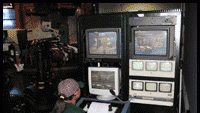Vinten Autocam at WAVY-TV/WVBT-TV

The control positions were located within the two studios to provide a more intuitive feel for the operator.
NBC affiliate WAVY-TV and FOX affiliate WVBT-TV, cover the Norfolk/Virginia Beach, VA, television market from the same studio complex and share all production equipment. With a typical week consisting of the production of well over six hours a day of live news, news production and breaking news coverage, the two stations needed a way to improve on one of the more expensive and labor-intensive aspects of their operation.
Prior to the installation of Vinten AutoCam robotics, studio cameras were always operated in a completely manual mode with a full studio crew. In addition, logistical issues would often pop up – for instance, the separate productions of two late newscasts would occasionally overlap due to network overruns on one of the stations. So, in addition to simply pursuing the labor savings that automating camera movements would provide, the stations were also looking for a better way to deal with the logistics of producing news for two separate stations co-located in the same facility.
In the process of shopping for robotics systems, we quickly narrowed the field down to two potential suppliers, with totally different types of systems. We chose the AutoCam solution because it would allow us to continue to use our existing Sony BVP-500 cameras.
The actual installation and training went quickly and smoothly. Prior to the arrival of the manufacturer’s technicians, we had measured all cable lengths and had them shipped in, ready for installation. We had also determined the location of the control positions and were prepared for the necessary equipment. This made it easy for the technicians to get the hardware assembled and begin the setup process. They placed the cameras on the new X-Y pedestals, and aligned and balanced them. The support equipment was placed in racks at the control position.
We chose to locate the control positions within the two studios, although it would certainly have been possible to locate them in the control room. Locating the controls in the studio seemed to provide a more intuitive feel for the operator, and allowed operators to glance at a pedestal to quickly reorient themselves during the process of learning the system.
The transition from manual to robotic went extremely well. We planned to go live with the system over a three-week period. In fact, we went live within two weeks because of the initiative of the crew and how quickly they learned to reliably control the system. There was only a short interim period during which camera operators were physically in place behind the cameras, operating the new robotic pedestals in a manual mode until the robotic operations were practiced to the point where everyone was confident that a show could be produced without error.
Get the TV Tech Newsletter
The professional video industry's #1 source for news, trends and product and tech information. Sign up below.
WAVY-TV and WVBT-TV selected Vinten AutoCam robotic camera controls because the new systems allowed the stations to preserve their investment in Sony BVP-500 studio cameras.
Viewers were no doubt completely unaware that there had been any change at all; we programmed all the same camera shots that we had been using before in order to provide continuity. Gradually new camera shots and angles were added to take advantage of the system’s ability to store many events.
When scripting a show using robotic camera operation, it is necessary to be sure that the shots being called for are technically and physically feasible. Camera position conflicts have to be resolved, and the time required for the X-Y pedestals to maneuver over a certain distance has to be taken into account. These would be issues for facilities using manual camera control as well, but with automation control any errors in planning are more difficult to correct at the last second.
System performance
The shows produced using camera automation look cleaner and more consistent, due to pre-programmed shots being used day in and day out. Using the same shot library across all shifts results in more consistency.
After the better part of a year, the system has proven to be reliable. Customer service personnel have quickly dealt with any small problems that have arisen. For the best results, the system does require a clean studio floor surface, and we have found that bits of old floor paint enamel have occasionally clogged up the optical sensor positioning mechanisms. We are planning to strip the enamel paint from the floors and repaint them with hard, epoxy-based paint. This should result in an even more reliable system that requires less frequent targeting to maintain accurate positioning.
Les Garrenton is director of engineering for WAVY-TV/WVBT-TV.
